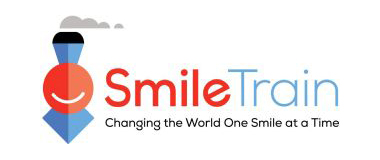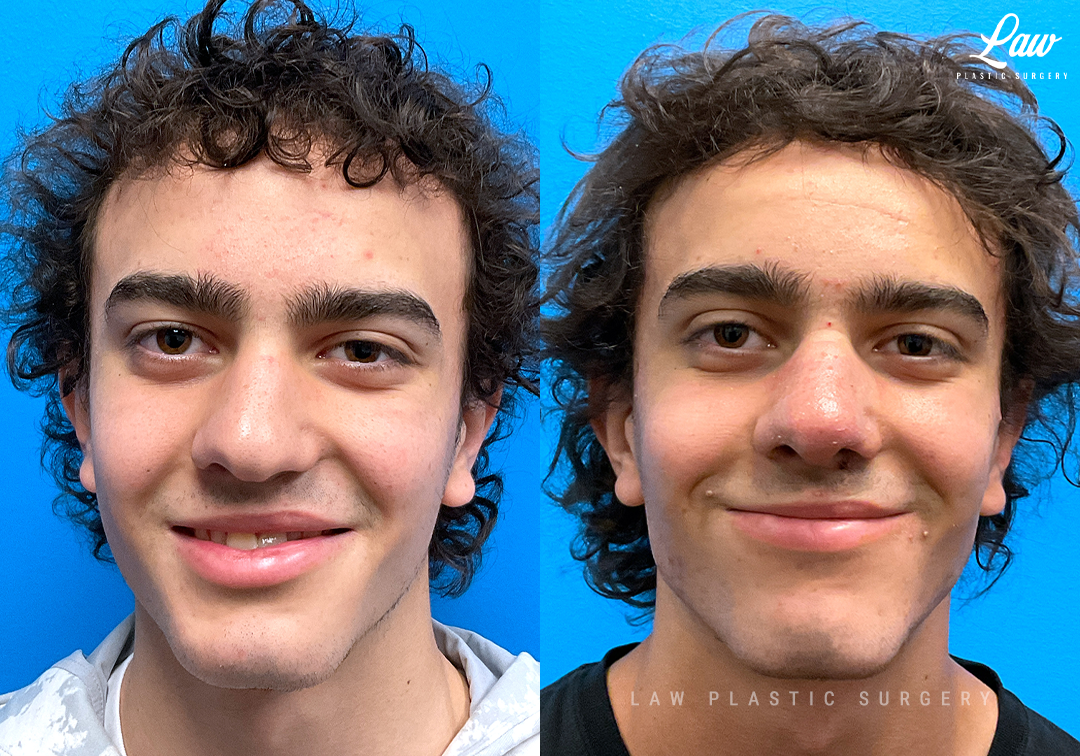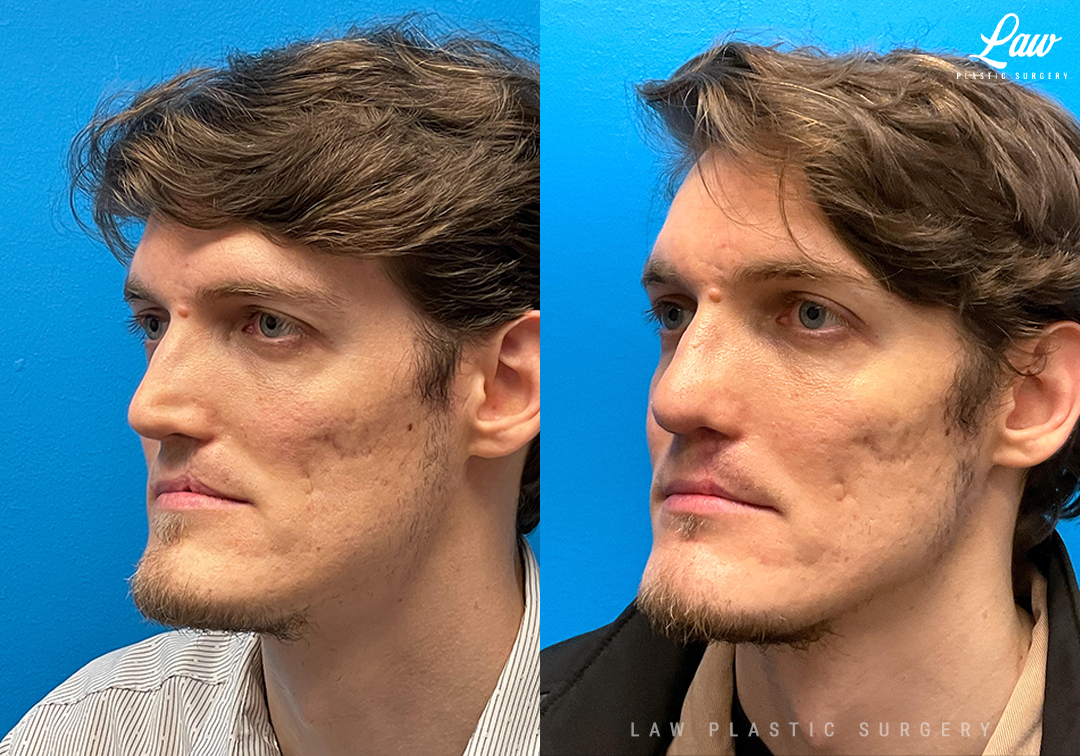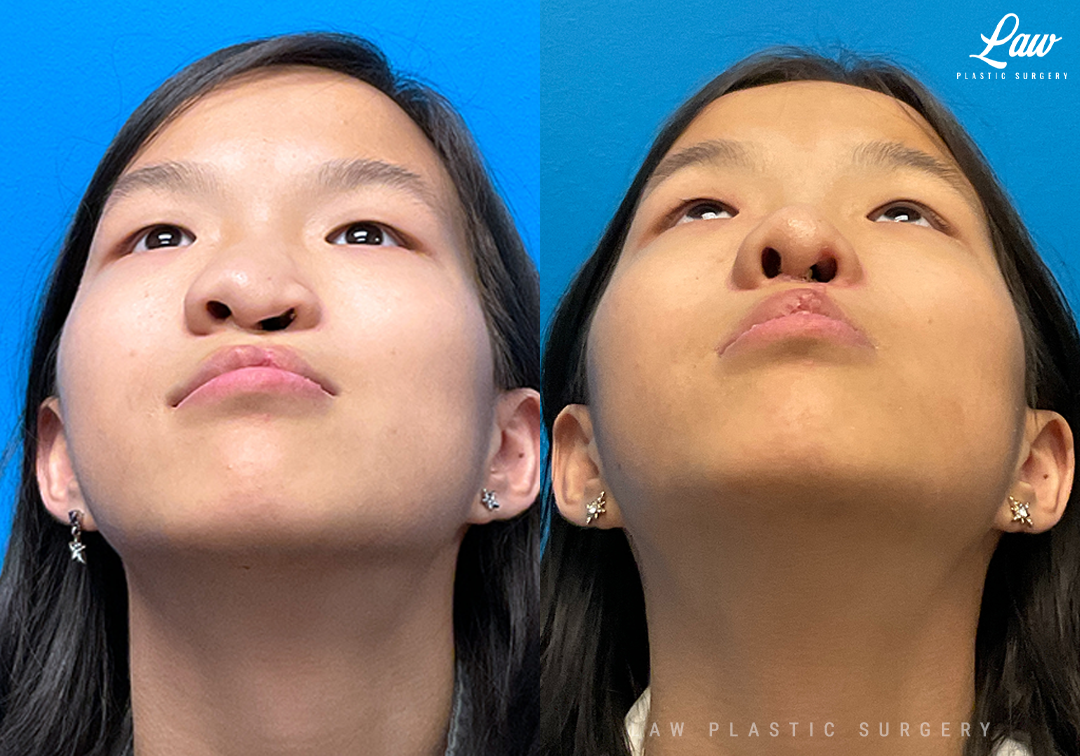Dallas Cleft Rhinoplasty (Cleft Nose Surgery)
Since the nose and lips are in the center of the face, they are prominent facial features. When an infant is born with a cleft lip and palate (aka orofacial cleft), nasal deformities may also exist. Dr. Huay-Zong Law addresses these abnormalities with a cleft rhinoplasty (aka cleft nasal reconstruction surgery). The terms cleft lip nasal deformity and cleft nose deformity are frequently used when referring to the nasal irregularities associated with a cleft lip and palate. A cleft rhinoplasty is a highly complex surgical procedure that, for optimal results, needs to be performed by a plastic surgeon who has experience correcting these kinds of irregularities. The initial repair of a cleft lip and nasal deformity typically occurs relatively soon following birth. This simultaneous repair may be the most important operation a child with a cleft lip and nasal deformity needs.
Patient Testimonials
Why Would Someone in Dallas Want to Have a Cleft Rhinoplasty?
The abnormalities seen with a cleft nasal deformity are structural and aesthetic. The goal of a cleft nasal reconstruction surgery is to reshape the underlying structure of the nose as well as its outer tissues to correct internal and external abnormalities.
Individuals usually want to have cleft nasal reconstruction surgery to:
- Address a crooked nose.
- Reshape an uneven nasal tip or nostril.
- Remove visible bumps or dips in the nasal bridge.
- Improve the way his or her nose looks from the side (i.e., profile view).
- Address issues negatively affecting the individual’s ability to breathe comfortably.
- Change the size or shape of the nose so that it is in balance with the other features of his or her face.
Following a cleft lip revision and a cleft rhinoplasty, most patients enjoy an increase in their self-confidence level, improved emotional wellness and an overall feeling of comfort with their appearance.
Cleft Rhinoplasty Before & After Photos
Click the image below to view more before and after photos.
There is a Wide Spectrum of Nasal Deformities Associated with a Cleft Lip and Palate
Since the spectrum of a nasal deformity that develops with a cleft lip and palate varies greatly, it is vital that the plastic surgeon performing the cleft lip nasal deformity has extensive experience with this particular procedure. People choose Dr. Law to perform their corrective procedures because of his extensive experience performing orofacial cleft correction surgery and cleft nasal reconstruction procedures.
What is a Cleft Lip Nasal Deformity?
A cleft lip nasal deformity occurs in conjunction with a cleft lip and palate. The irregularities associated with a cleft lip and palate include a split or a hole in the roof of the mouth or the lip. In order to cause a cleft nose deformity, the hole or split must be large enough to connect the individual’s nose and upper lip.
The Complexity of the Cleft Rhinoplasty
Cleft nasal reconstruction surgery is more complex than the typical rhinoplasty (aka nose reshaping procedure, nose job). A cleft rhinoplasty in Dallas is more complex due to the type of irregularities associated with this type of deformity.
The cleft lip nasal deformity affects every tissue layer of the nose, including the osseocartilaginous vault, mucosal lining and external skin; to perform a cleft lip nasal reconstruction surgery correctly, the plastic surgeon must be well versed in each of these areas. In addition, the surgeon must have expertise performing pediatric and adult plastic surgery, as well as with correcting the unique anatomical characteristics resulting from a cleft lip and palate (e.g., scar tissue).
Cleft nasal reconstruction surgery is an extremely challenging procedure. Besides being complex and delicate, surgeons usually have to wait until the patient is at least 15 to perform the second cleft rhinoplasty.
What Makes the Cleft Rhinoplasty Procedure So Complex?
Dr. Huay-Zong Law performs cleft nasal reconstruction surgery to address underlying physical irregularities, which improves the appearance of the face.
These unique challenges include:
- The nose is in the middle of the face, which makes it highly visible. Any procedure performed in this area is risky, which is why choosing an experienced plastic surgeon to perform a cleft nasal reconstruction surgery is vital.
- Prior surgical procedures in this area typically lead to the body creating scar tissue.
- Some patients create an excessive amount of scar tissue; therefore, the plastic surgeon performing the second cleft rhinoplasty must have experience removing scar tissue.
- The dimension and shape of the nose varies from one patient to the next, which is why the technique for correcting a cleft lip nasal deformity varies as well.
- Many patients need Dr. Law to perform several surgical techniques to address a nasal deformity due to a cleft lip.
To provide each of his patients with optimal results, Dr. Huay-Zong Law creates individualized surgical procedure plans to correct orofacial clefts and a cleft nose deformities.
There Are Two Types of a Cleft Nose Deformity: Unilateral and Bilateral
When resulting from a cleft lip and palate, there are two kinds of nasal deformities, the unilateral cleft nasal deformity and the bilateral cleft nasal deformity.
1. The Unilateral Cleft Nasal Deformity
The term unilateral cleft nasal deformity refers to the presence of a nasal deformity on just one side of the nose. When compared to the non-cleft side, the cleft side sits a bit higher and is somewhat displaced. This displacement occurs because the arch forms that are responsible for defining the nose collapse. This collapse causes the nasal tip to be less defined and reduces the projection of the nose, resulting in a widened dome. On the side with the cleft, the lateral crus is taller than the medial crus, which causes a less defined dome. The oblique nostril side typically blocks the nasal passage on the side of the nose with the cleft, which makes it difficult for the patient to breathe comfortably.
2. The Bilateral Cleft Nasal Deformity
With this cleft lip nasal deformity, the columella is missing or not long enough. This abnormality occurs when soft tissue and skin that should have developed between the upper lip and the nasal tip neglects to develop.
Cleft Rhinoplasty Before & After Photos
Click the image below to view more before and after photos.
A General Surgical Timeline for Orofacial Cleft Correction Surgery and a Cleft Rhinoplasty
When an infant is born with an orofacial cleft, Dr. Law performs the initial cheiloplasty to correct the cleft lip and cleft nasal reconstruction surgery to address nasal irregularities simultaneously. The cheiloplasty is usually performed within the first 12 months of life, but preferably between the ages of three and six months. The cheiloplasty concentrates on correcting lip separation, and the cleft nasal surgery concentrates on addressing visible and non-visible nasal irregularities. These irregularities frequently involve the structure of the nose.
When a cleft palate is present, Dr. Huay-Zong Law performs a palatoplasty to correct the cleft palate. He performs this surgery within the first 18 months of life, but preferably after the child turn 10 months of age. This delay in correction helps reduce the likelihood that the child will require another palatoplasty at some point in the future.
As time passes, a child with an orofacial cleft may experience uneven nasal growth. This asymmetrical growth frequently occurs due to scarring, which results in an abnormally shaped nasal tip. Dr. Law usually performs the patient’s second cleft rhinoplasty at some point during adulthood.
During the second cleft nasal reconstruction surgery, Dr. Huay-Zong Law corrects visible irregularities. In addition, when warranted, he addresses nasal bone and septum abnormalities to help the patient breathe more freely.
Cleft Nasal Reconstruction Surgery in Dallas Addresses Structural and Cosmetic Issues
Besides cosmetic improvements, during a cleft nasal reconstruction surgery, Dr. Law also addresses any functional airway irregularities associated with the nasopharynx and the nose. To achieve the desired result, Dr. Huay-Zong Law uses a variety of techniques to reshape the patient’s nose. He may harvest bone or cartilage from the patient to use as a graft while reshaping the nose. Once he completes the changes the patient desires, Dr. Law closes the incisions using very fine stitches. He may also use surgical tape and create a splint.
Cleft Lip Nasal Deformity Treatments in Dallas
There are two rhinoplasty procedures available, the open rhinoplasty and the closed rhinoplasty. When it comes to correcting a cleft nose deformity, Dr. Huay-Zong Law prefers to use the open version of the rhinoplasty procedure.
Cleft rhinoplasty procedures are broken up into three types of repair: primary, intermediate and secondary. Most patients receive their first cleft lip repair and cleft nasal reconstruction surgery during the primary procedure. Although primary procedures just need to be performed within the first year of life, Dr. Law usually likes to complete these procedures before the infant reaches six months of age.
A Primary Rhinoplasty in Dallas
Since a cleft nose and cleft lip are connected, when it comes to repairing and reconstructing these irregularities, it is vital that the plastic surgeon address both of these abnormalities during the primary surgery.
The purpose of a primary cleft rhinoplasty is to improve the shape, nasal tip projection and symmetry of the nose. Dr. Huay-Zong Law makes these improvements by clearing, tunneling and then realigning the lower lateral cartilages. Following realignment, the patient’s nose grows more symmetrically.
If Dr. Law addresses a bilateral cleft nasal deformity during a primary rhinoplasty, the changes he can make are typically limited. During the primary procedure, Dr. Huay-Zong Law can reposition the alar bases and reconstruct the patient’s nasal muscular ring. Patients who have a bilateral cleft nasal deformity will undergo nasal tip surgery during their intermediate surgical procedure.
Cleft Rhinoplasty Before & After Photos
Click the image below to view more before and after photos.
An Intermediate Rhinoplasty Procedure to Address a Cleft Nose Deformity
The intermediate rhinoplasty procedure is typically performed between the ages of four and six. Ideally, Dr. Huay-Zong Law likes to have this procedure completed before the patient begins kindergarten. By having the intermediate rhinoplasty at this time, Dr. Law can improve any minor lip issues and revisions to achieve a more normal nasal tip symmetry.
Dr. Huay-Zong Law performs intermediate rhinoplasty procedures to correct the position of the lower lateral cartilage on the cleft-side of the nose. By correcting this now, Dr. Law eliminates any concerns associated with the worsening of a cleft lip nasal deformity as the nose grows.
The intermediate rhinoplasty creates a more symmetrical appearance and makes correcting other nasal asymmetries easier.
A Secondary Rhinoplasty
The secondary rhinoplasty is usually the last procedure step that results in changing facial features. Females usually have their secondary rhinoplasty at some point between the ages of 14 and 16, whereas males have theirs between the ages of 16 and 18.
An Initial Consultation at Law Plastic Surgery in Dallas for a Primary Cleft Rhinoplasty
During the initial consultation, Dr. Huay-Zong Law needs the parent/guardian to let him know if the child has any medical conditions or allergies. Parents/Guardians should be able to provide Dr. Law with detailed information regarding the child’s medical history. If there were any irregularities associated with the child’s birth, please inform Dr. Huay-Zong Law of them at this time.
A Cleft Rhinoplasty: Primary and Secondary Surgery Steps
The Primary Cleft Rhinoplasty
Before Dr. Law begins a primary cleft nasal reconstruction surgery, the patient receives local anesthesia. Dr. Huay-Zong Law performs the primary cleft rhinoplasty during the same surgical session as the patient’s initial cleft lip surgery.
Sometimes, Dr. Law needs to perform bone grafts to build up any deficient and deformed tissue. Dr. Huay-Zong Law frequently performs these grafts using bone harvested from the patient’s nasal septum.
During the primary cleft rhinoplasty procedure, Dr. Law closes the nasal floor and addresses unevenness to create a more symmetrical nose.
A primary cleft nasal reconstruction procedure helps improve the function and aesthetic characteristics of the patient’s nose and face.
Cleft Rhinoplasty Before & After Photos
Click the image below to view more before and after photos.
What Parents Can Expect Following a Primary Cleft Rhinoplasty
Dr. Huay-Zong Law and his medical staff instruct parents on how to care for their child’s surgical site.
In order to reduce the likelihood of infection and alleviate pain, patients may receive prescribed medications. To ensure a comfortable recovery, parents need to give their child the medication as prescribed by Dr. Law.
The infant may receive padded arm restrictions. Dr. Law places these restrictions on the elbows to keep the baby from harming the surgical site. Parents should remove one padded arm restriction at a time for about 20 minutes, three times a day. After removing one of the arm restrictions, parents need to help the child move around his or her arms and hands. Please make these exercise times a priority, otherwise, the child’s hand and arm development may be negatively affected. Having both arms unrestricted simultaneously is not recommended because it may allow the infant to reach for the stitches.
Parents receive specific feeding instructions from Dr. Huay-Zong Law and his medical staff. Utensils, including pacifiers, bottles and straws can injure the surgical site; therefore, they must be avoided until Dr. Law releases the patient to use them.
Following surgery, patients need to follow some dietary restrictions. Solid foods must be avoided for several days. Instead, parents can give their child liquids (e.g., formula) and foods that have been liquefied or thinned (e.g., oatmeal, yogurt).
An Initial Consultation for a Secondary Rhinoplasty to Address a Cleft Lip Nasal Deformity
During the initial consultation, the patient needs to provide Dr. Huay-Zong Law with a detailed account of his or her medical history. If the patient has any ongoing conditions (e.g., diabetes, hypertension), please inform Dr. Law of these conditions. Previous surgeries must be included in the patient’s medical history. Any medications, herbs or vitamins that the patient takes regularly need to be disclosed to Dr. Huay-Zong Law.
Dr. Law may request that the patient have lab tests prior to his or her secondary rhinoplasty.
A Secondary Rhinoplasty to Address a Cleft Lip Nasal Deformity
The secondary cleft lip nasal reconstruction surgery is typically complicated. Dr. Law performs this procedure while the patient remains asleep under general anesthesia. When addressing a cleft lip nasal deformity, Dr. Huay-Zong Law usually prefers the open rhinoplasty technique.
An open rhinoplasty in Dallas: Procedure steps:
- Dr. Law creates a small incision in the patient’s columella. The columella connects all the relevant parts of the nose that Dr. Huay-Zong Law needs to correct.
- The patient’s nasal tip is folded upwards. This opens up the nose, providing Dr. Law easy access to the nasal passages.
- After Dr. Huay-Zong Law creates the desired nose shape, he uses sutures or stitches to close the surgical site.
- In addition, Dr. Law may place soft splints on the outside of the nose to help support its new shape. He may also place splints inside the nose to support the nasal septum.
- The splints and tape remain in place for at least seven days.
A secondary cleft rhinoplasty is usually performed as an outpatient procedure, which means the patient returns home once the anesthesia wears off.
Why Does Dr. Huay-Zong Law Use Grafting Material During a Secondary Cleft Lip Nasal Surgery?
The previous surgeries a patient undergoes to address a cleft nose deformity causes the development of scar tissue, which leads to the need for grafting material. This is the material Dr. Law uses to create the nasal shape a patient desires.
The nasal septum is the easiest place from which to obtain cartilage and Dr. Huay-Zong Law usually needs to straighten the nasal septum during the patient’s cleft rhinoplasty procedure in Dallas anyway. However, when a patient needs more cartilage than usual to support the shape of his or her nose, Dr. Law may harvest cartilage from the patient’s ribs or ear.
Cleft Rhinoplasty Before & After Photos
Click the image below to view more before and after photos.
Patients Having a Secondary Cleft Rhinoplasty Need a Driver
Since the patient receives general anesthesia during a secondary cleft rhinoplasty in Dallas, he or she must bring a driver on the day of surgery. The use of public transportation and any other for-hire driving services is prohibited following surgery that requires general anesthesia. This policy ensures that Dr. Huay-Zong Law’s patients are not taken advantage of, since they will be somewhat compromised following their surgery (due to the general anesthesia).
What to expect following a secondary cleft rhinoplasty procedure in Dallas:
Following the use of general anesthesia, it is common for patients to feel groggy for the remainder of the day. For this reason, Dr. Law requests that a caregiver remain with the patient overnight.
Dr. Huay-Zong Law requests that his patients rest for a few days after their secondary cleft rhinoplasty. Taking some time to rest helps speed up the body’s healing process. Pain, inflammation and bruising are common side effects of a secondary cleft rhinoplasty. Nonetheless, these side effects usually subside within just a few days.
Patients may receive prescriptions for medications and/or antibiotics following their procedure. These medications must be taken as they are prescribed.
Before heading home, patients receive instructions regarding their surgical site. For example, patients should avoid showering and instead take a bath. In addition, extreme facial expressions and vigorous exercise should be avoided for several days.
Recovering after a cleft rhinoplasty in Dallas:
- Patients need to take at least a week off school, work and any other regular activities.
- For the first week following a rhinoplasty, patients need to sleep in an upright position, at a 45-degree angle. Sleeping in this position helps control nasal inflammation.
- During the first week of recovery, instead of using pain medication, most of Dr. Law’s patients use natural remedies to address inflammation and pain (e.g., cold compresses).
- Patients must avoid wearing eyeglasses following surgery. Some patients find it helpful to tape the glasses to their forehead using medical tape.
- Since the nerves in the nose are temporarily affected, an itching sensation in the nose may occur. Patients must not scratch their nose because this could affect the sutures or the pliable nose structure. Dr. Huay-Zong Law can provide patients with advice on how to deal with this side effect.
- Patients need to refrain from sniffling or blowing their nose for at least a week.
- Dr. Law recommends that patients keep tissues close by. These tissues can be used to catch any fluid dripping from the nose.
- Exercise and other activities that can raise the heart rate must be avoided for six weeks.
Results
It can take quite some time for the results of a cleft rhinoplasty to become evident. Routine follow-up appointments allow Dr. Huay-Zong Law to examine the patient’s nose to ensure the healing process is moving along as planned.
A Septoplasty Addresses a Deviated Septum
In the event that a patient has a deviated septum, Dr. Law can add a septoplasty to the patient’s personalized surgical treatment plan. A deviated septum obstructs the nasal passages, making breathing difficult. During a septoplasty, Dr. Huay-Zong Law corrects the deviated septum, allowing air to flow freely through the patient’s airways.
Possible Side Effects and Risks Associated with a Cleft Rhinoplasty in Dallas
One of the best ways to reduce the likelihood of experiencing a complication is to choose an experienced, board-certified plastic surgeon to perform this procedure.
Cleft Rhinoplasty Before & After Photos
Click the image below to view more before and after photos.
Potential risks include:
- Tingling sensations.
- Inflammation.
- Bruising.
- Nasal congestion.
- Discomfort and pain.
- Infection.
- Permanent damage to tissues.
- An undesirable outcome
- The need for a revision.
How Much Does Cleft Nasal Reconstruction Surgery in Dallas Cost?
Since each cleft nasal reconstruction surgery is personalized to meet the needs of a specific patient, the only way that Dr. Law can determine the cost of an individual’s surgery is with an initial consultation.
If a cleft nasal reconstruction is not done correctly, it is highly likely that additional corrective nasal surgeries will be required. Correcting a cleft lip, a cleft palate and a cleft nasal deformity can greatly improve an individual’s self-esteem, as well as increase his or her confidence level.
At Law Plastic Surgery in Dallas, Dr. Huay-Zong Law uses his artistic vision, experience and skill to help people with orofacial cleft and nasal deformities attain the look and structural changes they desire. He dedicates himself to providing each of his patients with individualized surgical plans to create beautiful, natural-looking results. If you are in the Dallas area, and you would like to find out more about orofacial cleft surgery, including the cleft rhinoplasty, contact Law Plastic Surgery today at (972) 331-1900. Dr. Huay-Zong Law’s office is located at 7777 Forest Lane, C-528, in Dallas.
Cleft Rhinoplasty Before & After Photos
Click the image below to view more before and after photos.
Cleft Rhinoplasty FAQs
What is different about cleft rhinoplasty from noncleft rhinoplasty?
Will I be able to breathe better?
Will there be incisions on the outside of my nose?
Will you need to take cartilage from my ear or rib?
Can you make the cleft side of the nose look like the other side?
Related Procedures












